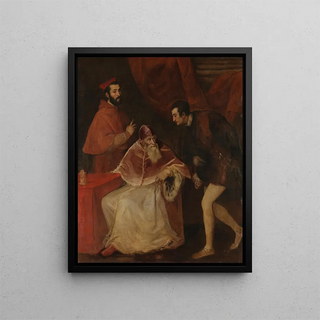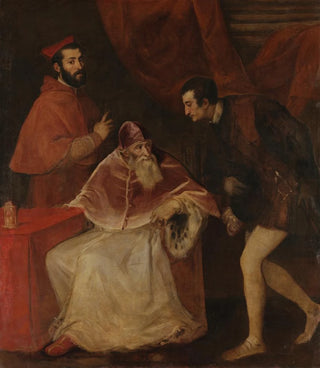Art print | Pope Paul III and his grandsons - Titian


View from behind

Frame (optional)
The artwork "Le pape Paul III et ses petits-fils" by the Venetian master Titian is an iconic piece of the Renaissance, capturing the very essence of power and family intimacy within the Catholic Church. Created in the 1540s, this masterful canvas not only depicts a churchman at the height of his career but also immerses us in the personal universe of the pope, surrounded by his two grandsons. Paul III's penetrating gaze, combined with the gentle features of his descendants, creates a fascinating contrast that invites reflection. This piece, both portrait and political statement, embodies Titian's genius, seamlessly marrying the grandeur of the subject with palpable humanity.
Style and uniqueness of the work
Titian, renowned for his mastery of color and his ability to capture light, stands out in "Le pape Paul III et ses petits-fils" with a rich and nuanced palette. The sumptuous drapery of the clothing, highlighted with golden touches, evokes wealth and power, while the faces of the characters are rendered with a delicacy that reflects meticulous observation. The artist employs chiaroscuro techniques to accentuate volumes and bring the figures to life, creating an atmosphere that is both solemn and intimate. The composition, centered on the pope and his grandsons, establishes a harmonious balance, where each character finds their place within the whole. This work is not limited to a simple portrait; it is a true visual narrative that tells the story of a dynasty while highlighting the political stakes of the era.
The artist and his influence
Titian, an emblematic figure of the Renaissance, profoundly influenced art history through his innovative approach to portraiture and religious painting. Born in Veneto, he established himself as one of the greatest painters of his time, influencing generations of artists with his technique and sense of composition. His work on portraits, in particular, redefined how figures were depicted, integrating a psychological and emotional dimension rarely achieved before.

Matte finish

View from behind

Frame (optional)
The artwork "Le pape Paul III et ses petits-fils" by the Venetian master Titian is an iconic piece of the Renaissance, capturing the very essence of power and family intimacy within the Catholic Church. Created in the 1540s, this masterful canvas not only depicts a churchman at the height of his career but also immerses us in the personal universe of the pope, surrounded by his two grandsons. Paul III's penetrating gaze, combined with the gentle features of his descendants, creates a fascinating contrast that invites reflection. This piece, both portrait and political statement, embodies Titian's genius, seamlessly marrying the grandeur of the subject with palpable humanity.
Style and uniqueness of the work
Titian, renowned for his mastery of color and his ability to capture light, stands out in "Le pape Paul III et ses petits-fils" with a rich and nuanced palette. The sumptuous drapery of the clothing, highlighted with golden touches, evokes wealth and power, while the faces of the characters are rendered with a delicacy that reflects meticulous observation. The artist employs chiaroscuro techniques to accentuate volumes and bring the figures to life, creating an atmosphere that is both solemn and intimate. The composition, centered on the pope and his grandsons, establishes a harmonious balance, where each character finds their place within the whole. This work is not limited to a simple portrait; it is a true visual narrative that tells the story of a dynasty while highlighting the political stakes of the era.
The artist and his influence
Titian, an emblematic figure of the Renaissance, profoundly influenced art history through his innovative approach to portraiture and religious painting. Born in Veneto, he established himself as one of the greatest painters of his time, influencing generations of artists with his technique and sense of composition. His work on portraits, in particular, redefined how figures were depicted, integrating a psychological and emotional dimension rarely achieved before.






